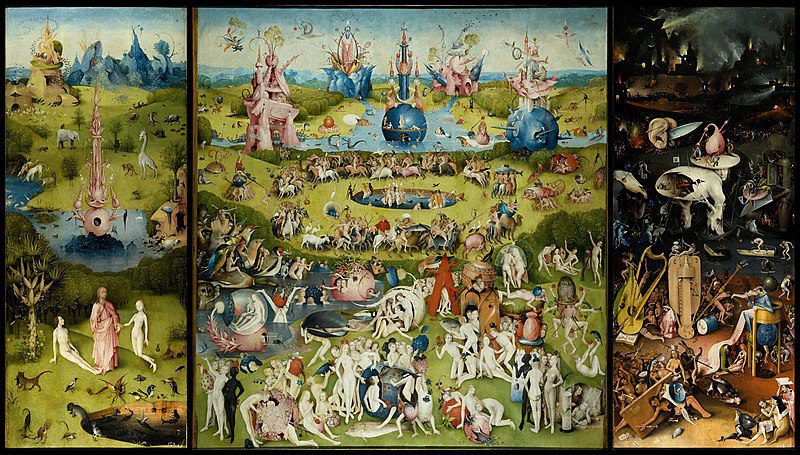Nora Fisher-Campbell
Portland, Oregon, United States

I have returned repeatedly to The Garden of Earthly Delights as a strange and fascinating representation of the human experience. The triptych, painted in the late fifteenth to early sixteenth century by Hieronymus Bosch, depicts a fever-dream vision of Eden, Earth, and the Last Judgement.1 On the left panel, God presents Adam and Eve with the garden: a serene greenspace punctuated with real and fantastical animals, deep blue pools, and a whimsical pink fountain perched atop a bed of gems and pearls. Life, in this vision, begins with respite.
The middle panel, though retaining some of Eden’s fountains, pools, and greenery, is far more chaotic and evokes energy and experimentation. The panel teems with life, overpopulated with both humans and animals. Naked humans ride the backs of horses, hogs, and large birds and cats. They frolic in pools, gorge on oversized fruits, and explore an environment filled with fanciful objects. The world—and their bodies—are their playground, and they think nothing of sin or that human lives are ephemeral. We might equate this with the journey our own bodies take through life: we use them (and sometimes abuse them) to experience our surroundings in ways that are pleasing to us. We experience life because we believe it is all that we have, and sometimes we suffer for it.
Bosch’s right panel starkly contrasts with the other two: here, humans suffer for their sins in a nightmarish vision of judgement. The panel is painted dark, with only the glow of fires and ghoulish white figures to light it. Humans are eaten by giant birds, impaled on the strings of a harp, carried off by demons, and endure many other tortures. Prominent in the panel are disembodied ears and a human head attached to what loosely resembles a ribcage pierced by ghostly white tree-legs. This scene, considering its religious origins, serves as a reminder of how humans will pay for their earthly sins. It also focuses on pain and loss of bodily integrity as real horrors that might take place at the end of one’s life.
Little is known of Hieronymus Bosch’s life, let alone his intentions when painting The Garden of Earthly Delights. Some consider it to be an earnest representation of religious teachings while others believe he may have found humor in the symbols and metaphors he used for immoral behavior.1,2 When viewed through a medical lens, we can interpret Bosch’s painting in several ways. If our focus is on the final right-sided panel, our outlook may in turn be focused on the negative: live poorly (drink, smoke, lie around), and you will suffer for it. Fault is placed with the individual who did not closely guard their health. It is easy for physicians to become restricted to this line of thinking, for in this view, their job is to scold and shake their head disapprovingly, hoping their well-intentioned efforts might prevent the misfortunes of panel number three. On the other hand, if feeling more charitable, we might look at that middle panel and consider that not every earthly pleasure has to lead to destruction. The physician’s role is not to scold, but perhaps to ward off demons of pain and the failing of the body by encouraging key adjustments. You can still ride the big cat—just remember to wear your helmet.
References
- Macdonald F. Hidden meanings in The Garden of Earthly Delights. Accessed March 15, 2023. https://www.bbc.com/culture/article/20160809-hidden-meanings-in-the-garden-of-earthly-delights.
- Kuiper K. Hiëronymus Bosch. Published February 18, 2023. Accessed March 15, 2023. https://www.britannica.com/topic/The-Garden-of-Earthly-Delights-by-Bosch.
NORA FISHER-CAMPBELL is a fourth-year medical student at Oregon Health and Science University. Her undergraduate degree is in art history, and she continues to enjoy making and viewing art as a pastime. She hopes to pursue her residency in pathology.
Submitted for the 2022–23 Medical Student Essay Contest and Highlighted in Frontispiece Volume 15, Issue 4 – Fall 2023

Leave a Reply